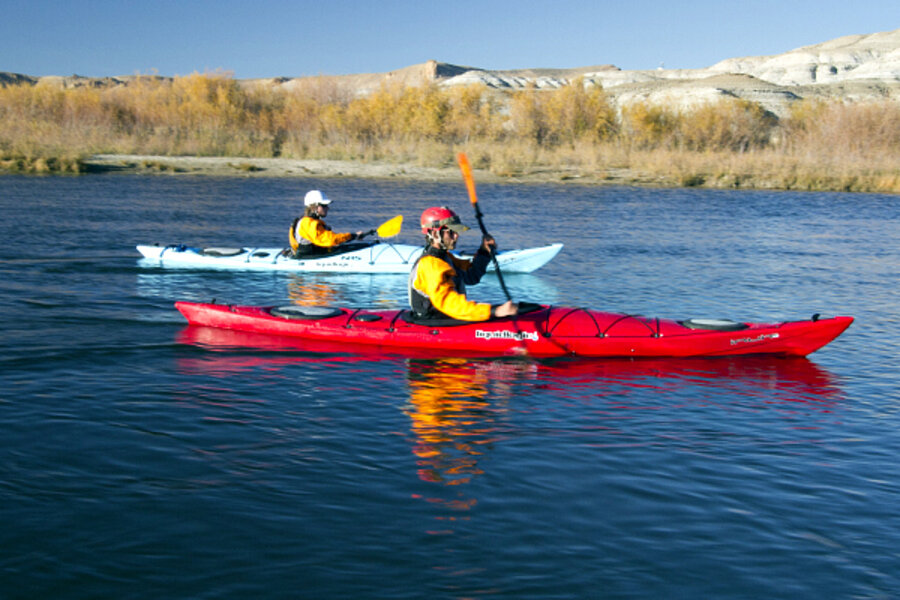Paddling down the Colorado River to surface its secrets
Loading...
The schedule: Get up at first light. Wait for the sleeping bags to dry out from the dew. Paddle or float down the Colorado River until dark. Try to find a beach on which to camp out – not always an easy task, with some of the land along the river being privately owned. Read and write at night. Go to sleep and start over again the next day.
Will Stauffer-Norris and Zak Podmore followed this plan for 110 days for their Source to Sea project, a collaboration with the State of the Rockies Project. The State of the Rockies, which was created by Colorado College in Colorado Springs, Colo., studies issues that are facing the Rocky Mountain region.
Mr. Stauffer-Norris, who is from Blacksburg, Va., and Mr. Podmore, who is from Glenwood Springs, Colo., came up with the idea of kayaking down the entire Colorado River, starting in the Wind River Range in Wyoming and ending in Mexico's Sea of Cortez. The aim was to study the state of the river and how it will impact Americans in decades to come.
QUIZ: How much do you know about America's landmarks? Take the quiz.
Both men graduated from Colorado College last May. Both have been on the water since childhood, kayaking and participating in other activities.
Stauffer-Norris in particular had wanted to do a longer-than-usual water voyage. “I just kind of wanted to see what would happen if you extended the trip over the entire river, being away from civilization,” he says.
When they mentioned the trip to a professor at Colorado College, he suggested they link it to the State of the Rockies Project, in which individuals work together to gather data about problems faced by the Rocky Mountain region and bring the problems to the public’s attention. The project for the 2011-2012 school year was to focus on the Colorado River Basin, an area of study that dovetailed with Stauffer-Norris and Podmore’s Source to Sea project.
One of the ideas they most want to impress upon people about the Colorado River, Stauffer-Norris says, is that the river is, in fact, a single body of water – a fact people often forget. “A lot of people don't think of the river as a whole,” he says.
As the two men paddled along they’d yell to people on shore about their plan to travel the entire river. They'd often get confused reactions from those who didn't realize that the river went as far as it does.
“You say, 'We're going to Mexico!' ” Stauffer-Norris says. “And people are like, 'What?' ”
They estimate they traveled 1,700 miles during their the four-month journey, with friends and their parents meeting them at a few spots. Their biggest discovery, Podmore says, was when they got further south.
“The findings were that there really wasn't a river anymore,” he says.
Stauffer-Norris says most of the water is visibly tainted as the river winds south. “It's pretty polluted,” he says. “There's not much left.”
The toughest part of the trip was when they reached Mexico and found there wasn’t any water to float on anymore, Stauffer-Norris says. “We had to load up all our water, our food, our rafts, and walk across the desert. We had to slog through knee-deep mud.”
During the trip, the two would sometimes stop and hike through areas on shore that looked particularly interesting. Boredom during their hours on the water wasn’t a problem, Podmore says. “We were at some of the most spectacular places in North America, in my opinion,” he says. “That was entertainment enough.”
“We ran out of things to talk about pretty quickly,” Stauffer-Norris adds, laughing.
They said that their biggest goal now that the journey is over is to inform people about what they saw. “We felt like we had the responsibility to get the message out there, that there was no water” in the southern Colorado River, Podmore says.
On Feb. 3, Stauffer-Norris and Podmore communicated by Skype with members of the US Department of the Interior about what they saw on their trip. The two will also present their findings at the yearly conference of the State of the Rockies Project in April.
They'd like those who live along the Colorado River to realize how their actions affect others, Stauffer-Norris says. If a person in Wyoming dumps garbage in the water, that will cause problems for someone living in Mexico.
“People will realize how interconnected the system is,” he says.
• Sign up to receive a weekly selection of practical and inspiring Change Agent articles by clicking here.





